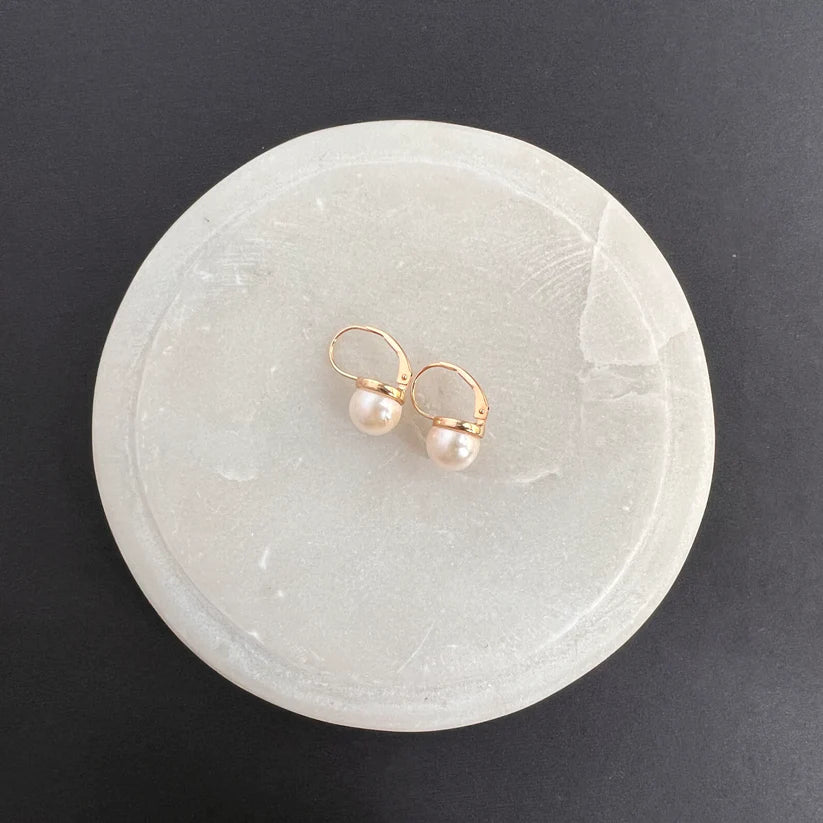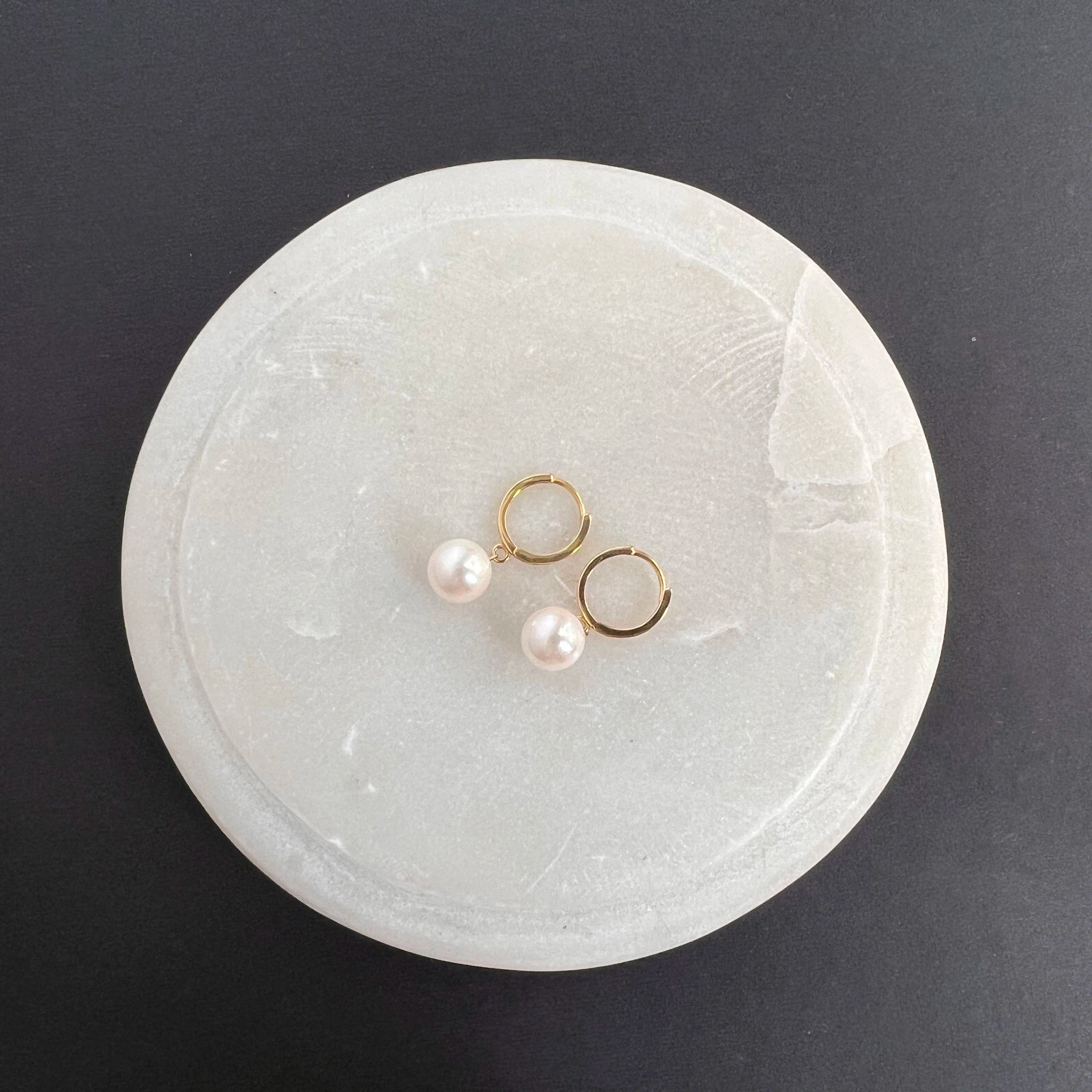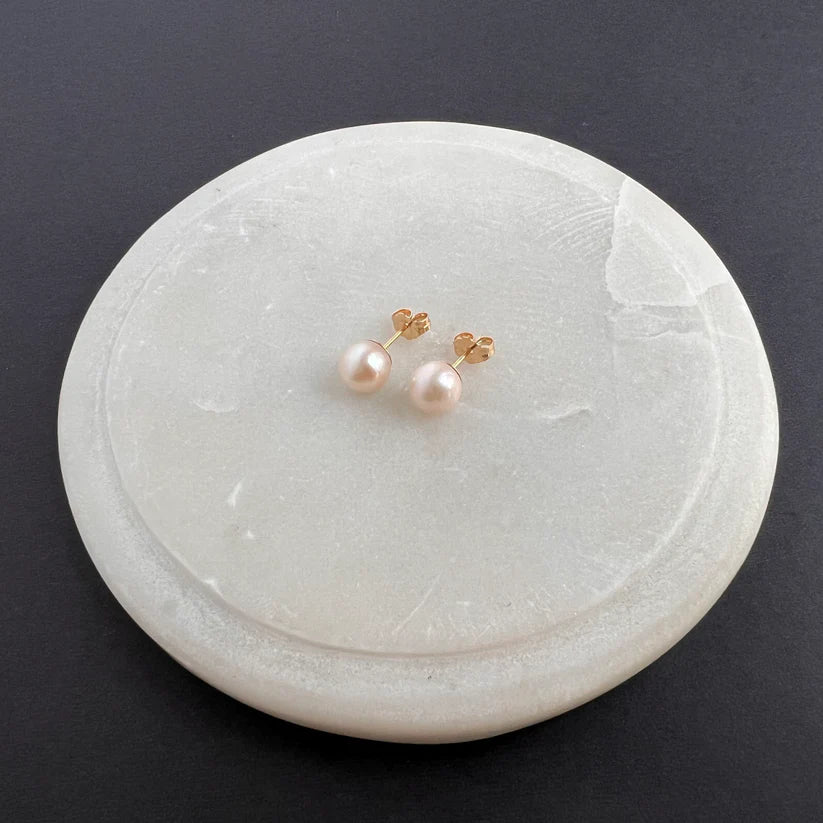How Much Are Real Pearls Worth? — 7 Pearl Value Factors that Matter [2024 Update]
Claudia Seti
March 4, 2024
As a first-time buyer or someone with a growing interest in pearls, you likely have questions, including "How much are real pearls worth?" or "Are they a worthy investment?"
Shopping for the perfect pearls can feel like swimming through the ocean without a life jacket. Price ranges vary wildly, from as low as $150 to as high as $300K (USD).
Every pearl has its own story, which affects its value. We'll discuss each of the 7 pearl value factors so you can better understand a pearl's worth.
Before we dive in, take a look at some of the online prices we've compiled in our research, ranging from budget-friendly to high-end.
Pearl Earrings Prices
From freshwater brands like Mejuri and A Sinner in Pearls, to saltwater brands such as Mikimoto, Pearls of Joy, and of course, us!
[On mobile, swipe left to see the full table]
| Pearl Type | Bali Perla | Mikimoto | Pearls of Joy | Mejuri | A Sinner in Pearls |
|---|---|---|---|---|---|
| Freshwater | ❌ | ❌ | $142 - $1,100 | $48 - $338 | $70 - $163 |
| Akoya | $155 - $319 | $2,300 - $190,000 | $170 - $1,800 | ❌ | ❌ |
| Tahitian | $207 - $408 | $2,400 - $8,000 | $227 - $3,100 | ❌ | ❌ |
| South Sea | Coming Soon | $4,700 - $45,000 | $284 - $6,600 | ❌ | ❌ |
*All prices converted to USD for easy comparison - February 2024
Pearl Necklace Prices
| Pearl Type | Bali Perla | Mikimoto | Pearls of Joy | Mejuri | A Sinner in Pearls |
|---|---|---|---|---|---|
| Freshwater | Coming Soon | ❌ | $184 - $2,000 | $98 - $398 | $94 - $403 |
| Akoya | $213 - 281 | $4,900 - $29,000 | $284 - $11,800 | ❌ | ❌ |
| Tahitian | ❌ | $3,500 - $43,000 | $213 - $38,000 | ❌ | ❌ |
| South Sea | Coming Soon | $45,000 - $60,000 | $268 - $284,000 | ❌ | ❌ |
*All prices converted to USD for easy comparison - February 2024
Most Expensive Pearl Type
Most Expensive Pearl Jewelry
Necklaces typically cost more simply because they contain more pearls.
Most Expensive Pearl Brand
Mikimoto prices start at $2,400 and can go up to $235K when diamonds are added.
This article will feature insights from Mark Lee, renowned Founder and President of M.L. Facets Gem Services Inc.
With his extensive background, Mark, a Fellow of the Canadian Gemmological Association and its former Treasurer, brings invaluable expertise from his distinguished career in gemology. His wealth of experience proves essential for anyone seeking informed decisions about pearls.
What are the 7 key pearl value factors that help determine worth?
1. Pearl Lustre - is it the most critical factor?
Lustre is the most important of the 7 pearl value factors because of its connection to the quality of nacre.
Pearls with high lustre appear bright and glossy, while pearls with low lustre may look dull or cloudy.
Finer-quality pearls will always display brighter and sharper reflections than less-quality ones.
We asked Mark Lee why lustre is so essential:
"Lustre is the most critical quality aspect of pearl jewelry. It refers to the intensity and quality of the light reflections from the pearl's surface and inner layers. Lustre is a direct indicator of a pearl's health, the thickness of its nacre, and, consequently, its beauty and value. While size, shape, and colour contribute to a pearl's allure, the lustre breathes life into it."
2. Nacre Quality - what is it?
Nacre is a combination of calcium carbonate and a protein called conchiolin. It's the substance that forms the lustrous layers within a pearl.
For example, pearl farmers insert a tiny bead in the oyster, which acts as a nucleus.
Over time, the oyster covers the bead with nacre, forming layers and making a pearl. The better the quality of these layers—how thick and shiny they look—the more valuable the pearl.
Pearls with thick, shiny layers of nacre look better and last longer.
Nacre thickness on Akoya pearls is typically between 0.3 and 0.6mm, Tahitian pearls are between 0.8 and 2mm, and South Sea pearls are the thickest saltwater pearls, ranging from 2 to 3mm.
3. Colours - do they matter?
A pearl's natural colour impacts its value because certain hues are more desired and rare.
According to GIA, pearl colour consists of three main elements:
- Bodycolour: It's the pearl's primary colour, such as white, cream, or black.
- Overtone: Think of overtone as a layer of extra colour on top of the bodycolour. It's like a subtle hint of another colour that adds depth and beauty to the pearl.
- Orient: Orient is like a shimmering effect that you might see on the surface of the pearl. It's like a colourful rainbow that appears when light reflects off the pearl in a certain way, making it look even more enchanting.
While all pearls have a bodycolour, not all have overtones or orients. It's the overtone and orient that makes a pearl rare, unique, and more valuable.
For example, white pearls are more valuable when they have a pink hue overtone because it’s rare. The same goes for black pearls that have a purplish and bluish hue overtone because they’re extremely rare.
Pearls with muted colours (no overtone and orient) or those that have been artificially dyed are much less valuable than naturally coloured pearls.
4. Pearl Size - are larger pearls more valuable?
Larger pearls are more complex to cultivate, less common, and considered more valuable.
However, pearl size is not always synonymous with its value. When determining the overall worth of a pearl, you need to consider the other pearl value factors.
In general, when other value factors within the pearl type are the same, the larger the pearl will be more valuable.
- When all other factors are equal, a 10mm Akoya pearl could be more valuable than a 10mm South Sea pearl.
- This is because Akoya pearls are usually smaller, ranging from 2.0mm to 10mm, while South Sea pearls are larger, usually between 8mm and 20mm.
- So, a 10mm Akoya pearl is rarer and worth more, since it's at the top end of the Akoya size range, but the same size is more common for South Sea pearls.
5. Pearl Surface - do imperfections matter?
All types of pearls have some imperfections. It's extremely rare to find pearls with a flawless surface.
These pearls can sell for a higher price than those with noticeable spots, pits, scratches, or wrinkles on their surface. When all other value factors are equal, pearls with fewer visible imperfections on their surface tend to command higher values.
Because a flawless surface reflects light more evenly, enhancing the pearl's lustre and overall appearance.
6. Pearl Shape - are round pearls the most valuable?
Perfectly round pearls are the most valuable because they require precise cultivation techniques that make them rare.
Slightly off-round pearls still hold value, while baroque pearls, with their irregular shapes, are popular for their uniqueness and individuality.
Button pearls, tear-drops, and pear-shaped pearls are valued because they are suitable for a wide range of jewelry.
With their symmetrical elongated shape, oval pearls also hold value for their adaptability in jewelry designs.
7. Pearl Matching - is it better to have matching pearls?
When you’re shopping for pearl earrings or necklaces, pay close attention to how well the pearls match. Are they similar or vastly different?
The closer they match, the more costly the pearl jewelry piece.
Jewelery designers aim to achieve uniformity across all pearls within a strand or earring set.
What pearl type is the most valuable?
We've compiled rankings for the four types of pearls to give you an idea of their average costs. Prices can vary. While South Sea pearls are usually the most expensive, there are times when an Akoya piece might cost more. As you know by now, it comes down to the 7 pearl value factors.
South Sea Pearl jewelry is typically the most expensive.
- Large sizes
- Luxurious natural colours
South Sea pearls stand out for their exceptional sizes, ranging from 10mm to 20mm, making them some of the largest pearls in the world.
They also boast a remarkable range of colours, including silver, gold, and sometimes rare hues like champagne or rose.
Due to their rare sizes and lustrous surfaces, South Sea pearls are highly sought after for creating luxury and statement jewelry pieces.
Tahitian pearl jewelry is the 2nd most expensive.
- Exotic appearance
- Dark colours and vibrant overtones
Tahitian pearls are prized for their natural dark colours, ranging from dark grey to shimmering black with green, blue, or purple overtones.
Akoya Pearl jewelry is the 3rd most expensive.
- Classic round shape
- High lustre
- Smooth surfaces
Timelessness and tradition, while having high lustre, set Akoya pearls apart.
Freshwater pearl jewelry is usually the most affordable.
- Cheaper
- Not rare
- More accessible
Freshwater pearls are affordable and versatile. They are produced in large quantities, making them accessible to everyone. You can get freshwater pearls that look like classic white pearls, have pastel hues, and unique shapes like baroque.
It’s great to see anyone able to wear pearls because of freshwater types, but we still think saltwater, or what we like to call ‘salty’ pearls, is the way to go.
What makes pearl earrings so valuable?
The 3 core elements that make up the value of pearl earrings are:
1. Pearl Quality - this is all about the 7 pearl value factors.
- Do the pearls have an overtone and orient to go with the body colour?
- Do the pearls have a smooth surface reflecting light?
- Do the pearls have an almost perfectly round shape?
- Do the pearls have a thick layer of nacre helping it shine?
- Do the pearls look like they could be twins? Meaning do they match well?
- And most importantly, do the pearls have that unforgettable hypnotizing lustre?
2. Setting and Design - simple or complex craftsmanship can determine the value of pearl earrings.
For example, our drop earrings are priced slightly more than our stud earrings because they require more delicate craftsmanship and materials.
3. Metal - 925 Sterling Silver? 14K Gold? Platinum? The metal used will affect the price.
In case you’re wondering, our beautiful White Akoya and Black Tahitian pearls all sit in 14K gold earring settings.
Pearl earrings with diamonds or gemstones will increase their value. Mikimoto has some that cost $300K (USD).
BALI PERLA NOTE:
We keep our pieces simple for everyday wear, so don’t expect us ever to offer you a set of $300K earrings. We hope you’re happy with our pearl earrings, which range from $155 to $408 USD.
All of our beautiful Akoya and Tahitian pearl earrings sit in 14K gold settings.
BUYER TIP:
An official jewelry appraisal can help you determine the actual value of your pearl accessory. It's an evaluation of your jewelry that assesses factors like the quality of the materials used, the craftsmanship, and the market demand to determine its worth.
We provide jewelry appraisals on items over $500 in retail value.
What factors determine the value of a pearl necklace?
Necklace length
Pearl necklaces come in various lengths, typically grouped as:
- Choker: 14-16 inches
- Princess: 17-19 inches
- Matinee: 20-24 inches
- Opera: 26-35 inches
- Rope: 36+ inches
Typically, longer necklaces with more pearls command higher prices. However, it's crucial to note that the value isn't solely dependent on the number of pearls but also on their quality, which is assessed based on the seven pearl value factors.
For example, a princess-length necklace might cost more than a choker of the same quality because it requires more pearls and material. However, a choker with higher-grade pearls could still end up being pricier than a princess-length necklace.
BALI PERLA NOTE:
Bali Perla offers Akoya baroque pearl necklaces in 15”, 18” and 20” lengths.
For men wearing pearls, 18" fits like a choker, while 20" is more relaxed.
Type of Strand
A single line of pearls offers a classic and versatile look for various outfits and occasions. On the other hand, a double-strand necklace exudes elegance and sophistication, making a more pronounced statement.
Each style has its appeal, from simple to extravagant, which affects how valuable people think the necklace is and how jewelers appraise its worth.
Matching Significance
Imagine a necklace where every pearl looks like it was made for the one next to it—the same size, shape, colour, and beautiful shine.
That's what happens when pearls are well-matched. They're all on the same page, creating a seamless, eye-catching look. When shopping for pearls, look for this harmony—it's a sure sign of quality.
Graduated strands, which arrange pearls in a gradual progression of size, further enhance this aesthetic by adding depth and dimension to the necklace. With larger pearls at the center and smaller ones towards the ends, the necklace gets a gentle narrowing effect, boosting its elegance and charm.
Consistency in these aspects boosts the necklace's elegance and sophistication, increasing its desirability and value. When pearls match well, they reflect light evenly, creating a radiant glow that catches the eye.
Bali Perla’s Akoya Baroque pearl necklaces showcase pearls with irregular shapes, sizes, and textures and appeal to those who appreciate unconventional elegance.
This style allows for creative freedom in design, with pearls often interspersed with other gemstones or beads to enhance their distinctive character.
Here's what Mark Lee had to say about buying pearl jewelry:
"My advice to anyone looking to purchase a pearl necklace is to focus on three critical aspects: lustre, surface, and matching. A high-quality pearl necklace should have pearls that radiate light beautifully. Next, examine the surface of each pearl closely. Look for a smooth surface with minimal blemishes, as imperfections can affect the necklace's value and aesthetics. Lastly, consistency is key. The pearls in the necklace should match in terms of size, color, and lustre for a harmonious and elegant appearance. "
Are pearls a smart investment?
According to Mark Lee,
"My advice to first-time pearl earring buyers is this: Look beyond conventional beauty and embrace the unique. Focus on the lustre and surface quality of the pearls—these are key indicators of their allure and longevity."
Just to add onto what Mark has said pearls are a smart investment because,
- Environmental Sustainability:
Pearls are eco-friendly because they come from oysters that help improve water quality by filtering out pollutants and excess nutrients.
By investing in pearl jewelry, you can contribute to ensuring sustainable aquaculture practices and the preservation of marine ecosystems.
The same can’t be said for gemstones like diamonds.
- Enduring Value:
Real pearls are more than expensive—they represent style, grace, and timeless beauty that lasts ages.
A proper jewelry appraisal can help you ascertain the true value of your pearl, guaranteeing a tangible asset with enduring and appreciating value that can offer you long-term financial stability.
- Market demand:
The rising interest in pearls, particularly amongst celebrities and eco-conscious jewelry enthusiasts, has significantly upped their market demand. As more individuals seek sustainable and ethically sourced luxury items, pearls are becoming increasingly popular.
This growing demand indicates a promising investment opportunity.
- Unique Aesthetic appeal:
Let’s face it, pearls are simply stunning!
Their shiny surface and soft glow make them look classy and elegant. You can wear them for any occasion, from formal events to everyday wear. Whether you prefer traditional styles or more contemporary designs, pearls always stand out and attract many people.
That's why they're always in demand and loved by so many.
Conclusion
Knowing how much real pearls are worth involves size, shape, colour, lustre, surface, nacre, and matching.
Pearl earrings can cost anywhere from $50 to $190,000, while pearl necklaces are worth about $100 to $280,000 and sometimes more.
As a general rule of thumb, bigger pearl sizes (South Sea) are almost always more expensive than smaller pearls (Akoya) within the same pearl grade.
Freshwater pearl jewelry is typically cheaper than saltwater pearl jewelry.
Overall, the value of pearls changes depending on what people want and what's popular at the time. You must consider pearl quality and buy from trusted seller



